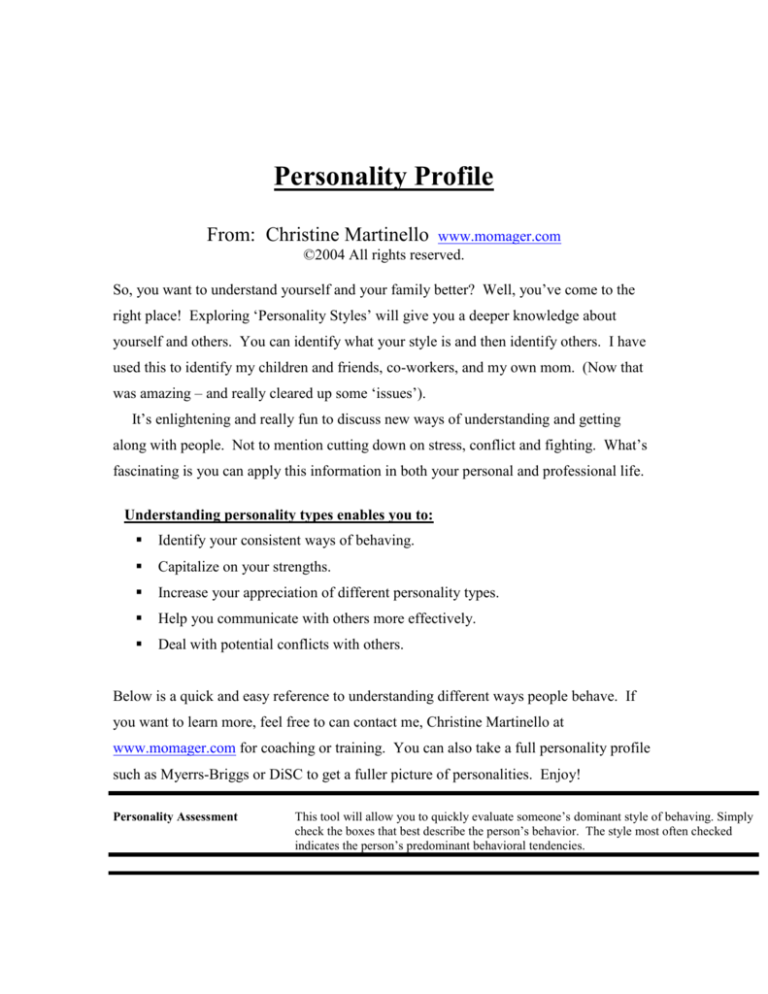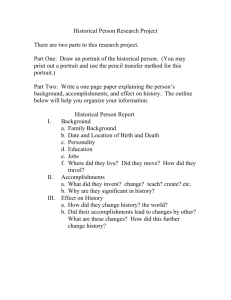
Personality Profile
From: Christine Martinello
www.momager.com
©2004 All rights reserved.
So, you want to understand yourself and your family better? Well, you’ve come to the
right place! Exploring ‘Personality Styles’ will give you a deeper knowledge about
yourself and others. You can identify what your style is and then identify others. I have
used this to identify my children and friends, co-workers, and my own mom. (Now that
was amazing – and really cleared up some ‘issues’).
It’s enlightening and really fun to discuss new ways of understanding and getting
along with people. Not to mention cutting down on stress, conflict and fighting. What’s
fascinating is you can apply this information in both your personal and professional life.
Understanding personality types enables you to:
Identify your consistent ways of behaving.
Capitalize on your strengths.
Increase your appreciation of different personality types.
Help you communicate with others more effectively.
Deal with potential conflicts with others.
Below is a quick and easy reference to understanding different ways people behave. If
you want to learn more, feel free to can contact me, Christine Martinello at
www.momager.com for coaching or training. You can also take a full personality profile
such as Myerrs-Briggs or DiSC to get a fuller picture of personalities. Enjoy!
Personality Assessment
This tool will allow you to quickly evaluate someone’s dominant style of behaving. Simply
check the boxes that best describe the person’s behavior. The style most often checked
indicates the person’s predominant behavioral tendencies.
Focus
Common
Behaviors
Work Station/Desk
Appearance
(if applicable)
Personal Appearance
Favorite Subjects
Favorite
Comments
Walking Style
Listening Style
“Bull”
“Monkey”
Clear, decisive,
takes charge, blunt,
positive
Approachable,
Sincere, patient,
persuasive, misses
actively listens,
deadlines,
possessive, loyal
optimistic,
enthusiastic
Colorful/creative,
Personal
pictures of self with
belongings, family
friends, designed to
pictures, calm
impress
environment
Stacks/piles,
multiple projects,
accomplishments
displayed
Bold,
unusual,
individualistic
Accomplishments,
likes business &
personal goals,
“Dog”
“Turtle” Logical, precise,
maintains systems,
critical, careful
Impersonal,
neat, graphs/charts
on wall, efficient
Comfortable, within Conservative, wellpolicy guidelines,
groomed, blends in
favorite clothes
policy
Family,
Details, processes,
trips,
impersonal subjects
hobbies
“Skip the details..”
“What’s bottom
line?”
Stylish,
trendy,
flashy
Memberships,
social
accomplishments,
themselves
“Let us, we, me...”
“What’s everybody
doing?”
Walks fast with
purpose, carrying
items or a project
Stops to talk to
people along the
way
Walks comfortably,
smiling at everyone
Wants brief
summary and will
review details later
Wants exchange of
ideas/opinions and
consensus building
Style Under Pressure Confrontational/
impatient, tighten
control, distant
Direct, resultsoriented, wants to
Managing Style
skip details, quick
“Let me think about “This is not
it...”
right...”
“How?”
“Why?”
Walks while
looking at item or
proofing a report
Wants time to
Wants proof of
digest information
information and
and consider others’
time to verify facts
opinions
Overly talkative,
Slow to change,
Perfectionist,
defensive, find the
stubborn, passive
formal, misses the
fun group
big picture
Influences, sells
Honest, democratic, Systematic,
ideas, team builder,
mediator,
focused, organizes
inconsistent
nonconfrontational
self/others, microdecision maker
with others
manages
# Of Checked
Overview - Four Different Personality Styles
Bull
This person’s emphasis is on shaping the environment by overcoming opposition to
accomplish results. A bull represents this person because they are strong, confident, and
welcome challenges. (Yes, they have been referred to as, “He’s like a bull in a china
shop”)
A Bull’s Tendencies Include:
A high level of confidence and a strong ego.
Likes to generate ideas.
Direct communication and quick decision-maker. Likes direct answers.
Thrives on challenges and solving problems.
Desires change.
Questions the status quo and causes action.
Each personality has strengths and weaknesses assigned to it. For the Bull to be more
effective, this person needs:
To understand they need people and recognize the needs of others.
Weigh pros and cons more carefully, research facts, and calculate risks.
Structure a more predictable environment.
To pace himself or herself and to relax more. They’re usually intense and driving.
To identify with a group.
Communicate reasons for their process and conclusions.
Communication Tips and Parenting Advice:
Be direct and straightforward. (Don’t go on and on.)
Highlight their accomplishments and respect their need for results.
Be clear about rules and expectations.
Let them be “in charge” and initiate when appropriate.
Respect their need for autonomy and independence.
Monkey
This type emphasizes shaping the environment by influencing or persuading others.
“Monkey See, Monkey Do” is this person’s mantra. These people influence others to
follow them or a cause.
A Monkey’s Tendencies Include:
Communicates in an articulate and persuasive way.
Enjoys contacting people and participating in a group.
Optimistic and enthusiastic.
Makes a favorable impression.
Creates a motivational environment.
Establishes democratic relationships.
For the Monkey to be more effective, this person needs:
Objectivity in decision making.
Participatory management.
Facts and a logical approach to decision making.
Priorities and deadlines to stay on task.
Direct communication.
Communication Tips and Parenting Advice:
Be relaxed and keep the conversation light.
Be sociable – use peer influence on them.
Let them verbalize thoughts and feelings (They like to go on and on).
Give public recognition for their accomplishments.
Help them get organized and teach them how to make decisions.
Dog
This type emphasizes cooperating with others to carry out the task.
Much like Lassie or a seeing-eye dog, this person is supportive, relaxed, cooperative, and
loyal.
A Dog’s Tendencies Include:
Consistent at performing in a predictable manner.
Loyal and patient.
Interested in helping others.
Good listeners who can calm excited people down.
Maintainers of the status quo, unless given reasons for change.
Wonderful at creating and maintaining stable, harmonious environments.
To be more effective, Dogs need to:
React quicker to unexpected change.
Obtain information on how their effort contributes to the total effort.
Seek guidelines for accomplishing the task.
Learn how to prioritize tasks.
Be more flexible in their approach.
Communication Tips and Parenting Advice:
Be relaxed and calm in your approach.
Be logical and systematic.
Provide a consistent and secure environment.
Show them how.
Teach them how to handle change and prioritize.
Turtle
This type of person emphasizes working conscientiously within existing circumstances to
ensure quality and accuracy. Like a turtle, this person likes to take their time and work
systematically. “Slow and steady wins the race.”
A Turtle’s Natural Tendencies Are:
Thinking analytically and logically, focusing on all the pros and cons.
Concentrating on performance standards and procedures.
Using a systematic approach to everything.
Subtle or indirect approaches to conflict.
Diplomacy with people.
Critical, detailed. and careful.
For this person to be effective:
Delegate important tasks.
Use policies and procedures as guidelines, not written in stone.
Initiate and facilitate discussions.
Encourage teamwork and other people’s opinions.
Develop problem-solving techniques and tolerance for conflict.
Communication Tips and Parenting Advice:
Accept they have little need to affiliate with other people. May need help with
sustaining friendships.
Give clear expectations and deadlines.
Be tactful and emotionally reserved.
Show them you value their high standards and help them not be too tough on
themselves as a perfectionist.
Be precise and focused.
Good-luck on your journey of exploring people and rewarding relationships!
Christine Martinello, speaker, Momager ™ (mom and manager) and business owner is
the best-selling author of The Momager TM Guide: Empowering Moms To Leave A
Loving Legacy. She is a wife and mother of three school-aged children. As a leadership
expert she offers insightful and practical seminars, speaking, and coaching. If you would
like to contact Christine or bring her expertise to your organization visit:
www.momager.com.
©2005Christine M. Martinello. Excerpt from The Momager Guide. All rights reserved.









